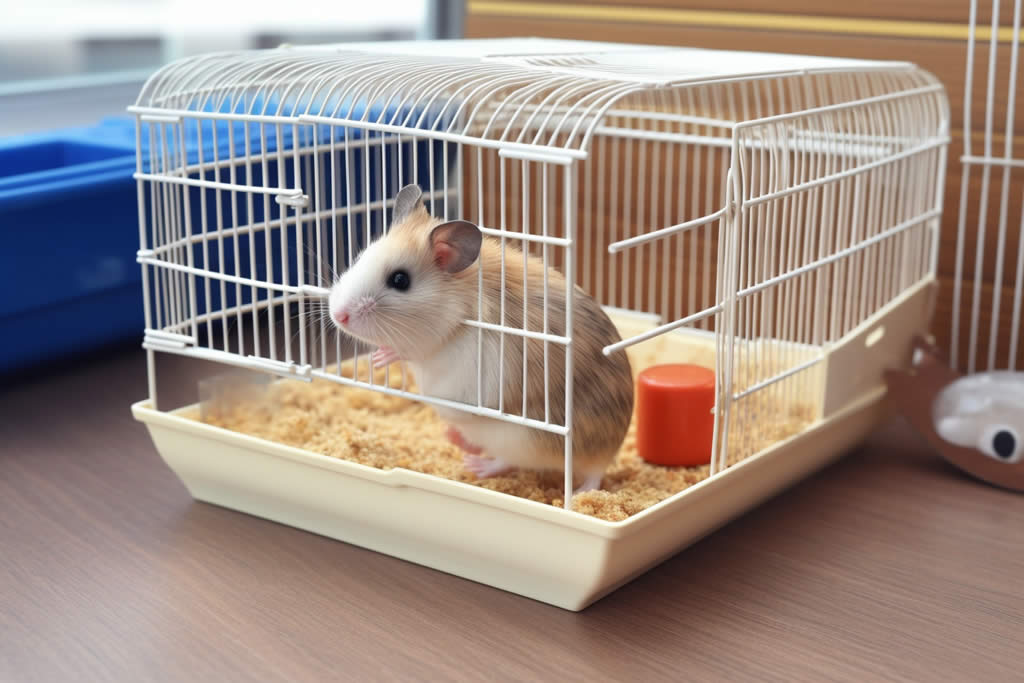Let’s talk about hamsters. Those adorable, squish-faced fluffballs? Total con artists. I learned this the hard way when my first hamster, Sir Nibbles von Fluffington III, vanished from his “escape-proof” cage within 24 hours of adoption. Spoiler: He was found three days later behind the fridge, hoarding cereal crumbs like a furry little survivalist.
If you’re tired of playing Mission: Impossible with your tiny escapee, let’s break down how to turn their cage into Fort Knox—without sacrificing their happiness.
1. Cage Choices: Size Isn’t Everything… Except When It Is
You wouldn’t want to live in a broom closet, right? Neither does your hamster. Pet store employees might push those colorful “starter kits,” but here’s the truth: Most are glorified shoeboxes.
- Floor Space: Aim for at least 600 sq inches (the German Animal Welfare Act’s standard). My Syrian hamster, Gouda, went from chewing bars to blissfully ignoring me after upgrading to a 40-gallon tank.
- Verticality ≠ Freedom: Multi-level cages with tubes look cool but become hamster highways to nowhere. Skip the plastic labyrinths and opt for wide, open spaces. Pro tip: IKEA’s glass display cabinets (like the Detolf) are DIY hamster paradise.
- Bar Spacing: Baby Syrians can squeeze through ½-inch gaps. Go for ¼-inch spacing or solid glass/plastic walls.
2. Doors, Lids, and the Art of Deception
Hamsters are lock-picking prodigies. My friend’s robo dwarf once popped a sliding door open using its nose.
- Latches: Spring-loaded latches? Child’s play. Use padlocks meant for birdcages or add binder clips to sliding doors.
- Weight the Lid: Wire tops can be pushed up. Stack books or use aquarium lid clips. One owner I know duct-taped a dumbbell plate to theirs (overkill? Maybe. Effective? Absolutely).
- The “False Front” Trick: Place toys or a wheel near the door. Distracted hamsters forget escape plans.
3. Boredom = Escape Motivation
A bored hamster is a hamster with a PhD in structural engineering.
- Digging: Give them 6+ inches of bedding. Coconut fiber + aspen shavings = burrow heaven.
- Toys That Lie: Hide treats inside toilet paper rolls stuffed with hay. They’ll spend hours murdering the roll instead of plotting.
- Wheel Science: Silent spinners prevent midnight squeak concerts. Size matters—a bent back causes spinal issues.
4. Handling: Don’t Be the Reason They Bolt
Ever seen a hamster yeet itself off a table? I have.
- The Pancake Method: Let them walk onto your flat hand. No grabbing—trust takes time.
- Playpen Rules: Use a kiddie pool lined with towels. Add tunnels, a sand bath, and supervise like they’re toddlers near a pool.
- Escape Kits: Keep a laundry basket nearby during playtime. Hamsters are shockingly fast.
5. Maintenance: Where DIY Meets Paranoia
Weekly cage cleanings aren’t just for smells—they’re recon missions.
- Chew Patrol: Check for gnawed edges, loose bars, or suspiciously smooth plastic (a sign of filing).
- Substrate Shifts: Rotate bedding types. My hamster once tunneled out using a paper towel roll as a ramp. Lesson learned.
- Food as Distraction: Scatter-feed instead of using a bowl. Foraging = less time scheming.
6. When the Unthinkable Happens: Escape Protocol
Stay. Calm. Panicking leads to stepped-on hamsters.
- The 10-Foot Rule: They rarely go far. Block door cracks and check:
- Behind/under appliances (warmth)
- Inside shoes (RIP my favorite sneaker)
- Potted plants (they’ll dig)
- The Bucket Trap: Place a tall, smooth-sided container with ramps leading up. Bait with peanut butter. Gravity = your ally.
- Night Stalking: Turn off lights, sit quietly, and listen for scratchscratchscratch.
Final Thoughts: Embrace the Chaos
Even with precautions, hamsters escape. Mine once lived inside our couch for a week, emerging only to steal almonds. But with patience and these tweaks, you’ll minimize jailbreaks and maximize cuddles (or at least less frantic furniture dismantling).
Remember: A happy hamster is a lazy escape artist. Now go forth and rodent-proof like your sanity depends on it—because it kinda does.



